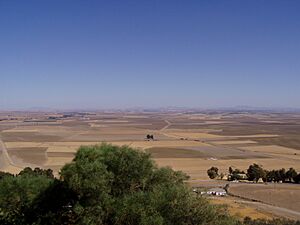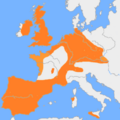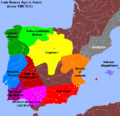History of Carmona, Spain facts for kids
The history of Carmona is very old, making it one of Europe's oldest towns. People have lived here for almost 5,000 years! Carmona sits on a high plateau above the Corbones River plain in Andalusia, Spain. It's about 30 kilometers from Seville and 250 meters above sea level. Because of its great location, Carmona has always been an important place. Many different groups of people have lived here, and they all left their mark on the city we see today.
Carmona's location was perfect because it was easy to defend. The land around it was also very fertile, which meant lots of food could be grown. This made it a natural stronghold, controlling paths to the central Guadalquivir valley and its resources.
Contents
Ancient Times: Early People and Settlements
People have lived around Carmona since very early times. We've found signs of people from the Stone Age, but much more from the New Stone Age (Neolithic period). Around 2500 to 2000 BC, a new culture called the Bellbeaker culture appeared. They made beautiful decorated pots. Later, in the Iron Age, Carmona was a settlement of the Tartessians. By the mid-8th century BC, a steady group of people lived on the plateau where Carmona is now.
Early Metal Use in Carmona
Farming became common around 3000 BC. This led to more people settling in the Los Alcores and La Campiña areas, which are now part of the province of Seville. The oldest settlement near Carmona was in the El Campo Real area. In 1898, an archaeologist named George Bonsor found 42 silos (underground storage pits) dug into the rock there. Some even had burials inside! This site dates from the end of the Neolithic period through the Chalcolithic (Copper Age).
The first settlement right where Carmona is today started about 4,500 years ago. People liked to live on the higher parts of the hills overlooking the fertile Corbones plain. Early homes were round huts, partly dug into the rock, with roofs made of branches and mud. Next to them were circular silos for storing grain. When these silos were no longer used, they were filled with tools like pottery, stone knives, and animal bones.
In 1888, a large ancient burial site called a dolmen was found. It had a 17-meter long corridor leading to a round chamber.
Bellbeaker Culture and Bronze Age
The Bellbeaker culture, known for its bell-shaped pottery, appeared around 2500 to 2000 BC. These pots were often decorated with patterns filled with a white paste. Many of these pots were found at a nearby site called El Acebuchal.
The Bronze Age began when people started using bronze (a mix of copper and tin) to make tools. This changed how people lived and organized their societies. During the Early Bronze Age (1800–1500 BC), three shaft tombs were found in a small cave in Carmona. Later, in the late Bronze and early Iron Ages, Carmona became a Tartessian settlement. This group of people lived on the plateau, controlling the roads to the Guadalquivir River.
Ancient Empires: Phoenicians, Carthaginians, and Romans
Phoenician Traders Arrive
Around the 8th century BC, Phoenician traders from Tyre arrived in Carmona. This changed everything! The simple Tartessian village became a city. Round huts were replaced by rectangular houses, built in the Phoenician style, and arranged in a planned way. The people also built strong walls on the western side of the city to protect it. This growth continued until the mid-6th century BC, when the Phoenician trade network broke apart.
Carthaginian Rule and the Punic Wars
After the Phoenicians, Carthage became the main power in the western Mediterranean. By the 3rd century BC, Carthage made Iberia (Spain) its new base for fighting against the Roman Republic. Carmona became an important Carthaginian trading city. Its name "Carmona" might even come from the Semitic words Kar (city) and Hammon (a sun-god worshipped in Carthage), meaning "city of Hammon."
The Carthaginians made Carmona's defenses even stronger. They reinforced the main entrance, now called the Puerta de Sevilla (Seville Gate), with huge stone blocks. This made Carmona a very strong fortress, which even Julius Caesar later mentioned!
The Punic Wars were a series of big wars between Carthage and Rome. In 207 BC, during the Second Punic War, a battle was fought near Carmona. The Roman general Scipio defeated the Carthaginian forces. This was a major victory for the Romans in Spain. After this, the Carthaginians were pushed out of the Iberian Peninsula by 206 BC.
Roman Carmona: Carmo
After the Romans conquered Carmona, they called it Carmo. It became a city that paid taxes to Rome and was even allowed to make its own coins with the name "Carmo" on them. Carmona was an important part of the Roman Empire.
In the second half of the 1st century AD, during a time of peace called the Pax Romana, Carmo became a major crossroads on the Via Augusta, a very important Roman road. This was a great time for Carmona's culture and economy. The city's layout today still follows the Roman plan, with its main streets, the Cardo Maximus and Decumanus Maximus, and the old forum area (now Plaza de Arriba) still being a busy center.
City Walls and Gates
Carmona's location on a high plateau made it naturally easy to defend. The Romans made these defenses even stronger with walls and fortified gates. Julius Caesar himself wrote that Carmona was "by far the strongest city of the province." Today, only parts of the Seville and Cordoba Gates remain.
- Seville Gate (Puerta de Sevilla): This gate and its strong tower were first built by the Carthaginians around 220-230 BC. The Romans later rebuilt parts of it. It has two arched spaces and a courtyard.
- Cordoba Gate (Puerta de Córdoba): This gate has been rebuilt many times. It has three columns on each side and two semi-octagonal watchtowers. The north tower was rebuilt after an earthquake in 1504.
Roman Forum and Public Buildings
The Forum was the heart of a Roman city, where all public life happened. It had temples, a basilica (a public building for business and law), and a market. Carmona's forum was located where the two main Roman roads met, in what is now the Plaza de Arriba.
Carmona also had an amphitheatre for public shows, located near the Roman Necropolis. It was partly carved into the rock. There might have been a Roman theatre too, but this is still being studied.
Public baths were also important in Roman life. Remains of a water heating system for public baths, dating to the 2nd century, were found under Calle Pozo Nuevo. In 1923, a Roman mosaic with the head of Medusa and goddesses representing the four seasons was found here. It's now in the City Hall.
Roman Homes and Cemeteries
Typical Roman homes in Carmona had rooms like kitchens, dining rooms, and bedrooms arranged around a courtyard. Rainwater was collected in a pool in the courtyard and stored in underground cisterns.
The Roman Necropolis of Carmona was a large cemetery outside the city walls, along the Via Augusta. It has hundreds of tombs, mostly from the 1st century BC to the 2nd century AD. Bodies were usually cremated, and their ashes placed in urns in niches inside underground chambers. These chambers were often plastered and decorated with paintings of birds, dolphins, and flowers.
Two famous tombs are the Tomb of Servilia and the Tomb of the Elephant. The Tomb of Servilia was very grand, built to look like a Roman villa with a courtyard and statues. It was a burial place for a rich family and showed off their wealth.
Late Roman and Visigothic Times
After the 3rd century, Roman Carmona slowly declined. The city became smaller, and some areas were no longer lived in. After the Western Roman Empire fell, the Visigoths took over Spain. Carmona might have been part of the Byzantine Empire for a short time (552–624 AD) before the Visigoths took it back.
Muslim Carmona: Qarmūnâ
From the early 8th century to the mid-13th century, Carmona was part of Muslim al-Andalus. It was called Qarmūnâ (قرمونة). The Muslim general Musa bin Nusayr conquered Carmona in 712. The Muslims allowed the people to keep their homes, religion, and customs if they paid a tax.
Carmona was an important political center during this time. It became the capital of a Kūra (an administrative district) and later a Taifa kingdom. In 1057, the Emir of Seville took control of Carmona. Later, in 1091, the Almoravids from North Africa took over all of Al-Andalus, including Carmona.
A geographer named Ibn Abd al-Munim al-Himyari described Qarmūnâ in detail around 1461. He mentioned its strong stone walls, gates like the Cordoba Gate and Seville Gate, and a large mosque (where the Church of Santa María is now). He also mentioned public baths and an armory.
The Muslim rulers also used and improved the castles in Carmona, like the Alcázar de Puerta de Sevilla and the Alcázar Real. The four Roman gates were still used. The mosque was built in the 11th century, and parts of it, like the Patio de los Naranjos (Orange Tree Courtyard), can still be seen today in the Church of Santa María.
Middle Ages: Christian Rule in Carmona
In 1247, the Christian King Ferdinand III of Castile conquered Carmona from the Moors. The city was then ruled by Rodrigo González Girón. The terms of surrender allowed Muslims to stay in their homes and keep their property and religion if they wished.
In 1252, King Alfonso X started a plan called the Repartimiento. This meant giving out land and homes to Christian settlers to repopulate the area. Nobles and knights received large estates, while common people received smaller plots of land with a home.
Peter I and Carmona's Castles
The reign of King Peter I (also known as Pedro the Cruel) from 1350 to 1369 was good for Carmona. He loved the city and made many improvements. Carmona had three castles: two defending the Seville and Cordoba gates, and a third, the Alcázar del rey Don Pedro, on the highest part of the city.
Peter I restored the old Muslim palace, the Alcázar del rey Don Pedro, making it a lavish palace with new towers. He also ordered another fortress, the Alcázar de la Reina, to be built. After Peter I's death, Carmona became a stronghold for his supporters. The Alcázar del rey Don Pedro was later destroyed by earthquakes in 1504 and 1755. Today, a modern hotel called a parador stands on its site.
The Alcázar de Abajo (Lower Fortress), near the Seville Gate, was also enlarged by Peter I. Many chapels around the city also date from his time.
From Civil Wars to Catholic Monarchs
After Alfonso X, Carmona faced tough times with raids and conflicts among the nobility. The city became very disorganized, with people refusing to pay taxes. This ended when Isabella I of Castile and Ferdinand II of Aragon, known as the Catholic Monarchs, came to power in 1479.
Carmona helped the Catholic Monarchs in the Granada War (1482–1492), sending soldiers and supplies. In 1630, King Philip IV officially made Carmona a "city" in exchange for a large sum of money.
By 1411, several parishes (church districts) had been formed, creating the basis for Carmona's neighborhoods today. The main mosque was torn down in 1424 to build the city's most important church, La Prioral de Santa María (Priory of St. Mary). The Convent of Santa Clara was founded in 1460.
The Iglesia de Santa María (Church of Santa María) was built from 1424 to 1551 in a Gothic style, with later Baroque additions. Its altarpiece is a famous work of art. The Patio de Los Naranjos has a Visigothic calendar carved into one of its pillars.
The Plaza de Arriba, now also called Plaza de San Salvador, was first mentioned in 1407. It was surrounded by public buildings and shops. Miguel de Cervantes, the famous writer, lived in Carmona for two months in 1590 while working for the Spanish Navy. The Casa del Cabildo (City Council House) is a Renaissance-style building from the 16th century on the Plaza Fernando III.
Modern Times: 19th and 20th Centuries
At the start of the 19th century, Carmona's economy relied mostly on growing wheat and olives for oil. There wasn't much industry or trade. A few rich landowners controlled the city council and didn't pay taxes, which made things hard for most people.
During the Peninsular war against Napoleon, Carmona's horsemen bravely fought in the Battle of Bailén in 1808, helping to defeat Napoleon's army. This is still remembered by the people of Carmona.
Even today, Carmona is still largely an agricultural city. Most people work on the land, growing wheat, olives, and grapes. The social structure was very strict, with nobles and clergy owning large estates, and many farm laborers living in poverty.
In the 19th century, after the government took and sold church property, the land ownership in Carmona changed. While the Church lost land, some noble families and large farmers gained more.
The city also started to modernize. The empty Santa Catalina convent became Carmona's first stable market, the Plaza del Mercado de Abastos. A new cemetery was built outside the city walls in 1840.
In the late 19th and early 20th centuries, Carmona saw more industry related to agriculture, like textile mills, olive oil production, and bakeries. New cultural societies were formed to promote science and learning.
In the 20th century, Carmona's population grew rapidly, especially in the 1960s. New neighborhoods were built to house the growing number of residents.
Images for kids
See also
 In Spanish: Historia de Carmona para niños
In Spanish: Historia de Carmona para niños











